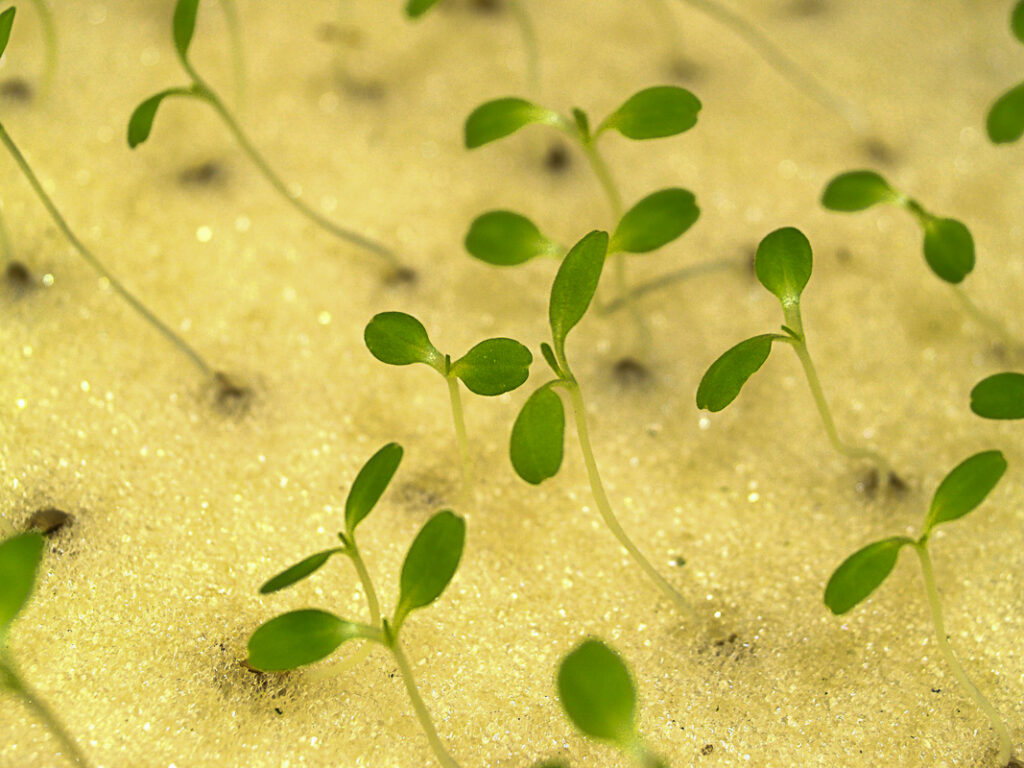There are many things to consider when choosing to grow hydroponically. One of the biggest the comparisons of hydroponics vs aeroponics. Both methods are highly efficient in growing a variety of plants. But which is best for you? In this post, we’ll look to answer the question of hydroponics vs aeroponics.
*This post contains compensated links. Find more info in my DISCLAIMER. As an Amazon Associate, I earn from qualifying purchases.
Want to start a hydroponic garden at home easily? Check out our recommendations for Best Hydroponics Starter Kits for Beginners.
What Is Hydroponics?
Simply put, hydroponics is the cultivation of crops in a nutrient-enriched water solution. It’s a method on the complete opposite side of traditional soil-based growing. Hydroponic plant roots are submerged in a nutrient-rich solution throughout the growing cycle. To provide support, a soilless medium like coconut shells or perlite is used.
For new home gardeners and growers, hydroponics is worth looking into. It works well both indoors and out. There are systems perfectly suited for small spaces like apartments and best of all, plants grow more quickly. Here’s a look at some of the different types of hydroponic systems.
Deep Water Culture (DWC)
Plants are placed in a tray or on a board, the roots are submerged continuously and hang beneath. These roots are held in net pots that contain a growing medium and hang right on the nutrient solution. However, an air stone is needed inside the reservoir to prevent the plants from drowning without good oxygenation.
Wick
Plants are placed on trays with a growing medium and placed right above the nutrient solution. A wick, preferably made of fiber for high absorption, connects the solution and the medium. Perlite and vermiculite are the best media in this case due to their high rate of absorption.
Nutrient Film Technique (NFT)
This system relies on one of the most constant things on Earth, gravity. In an NFT system, vegetable plants are hung using piping. To feed them, a nutrient-rich water solution is fed from the top of the NFT system, letting gravity pull the solution down over the plants. Running from top to bottom, the plants are water and nourish precisely. Energy-efficient and good for the environment, the water solution is collected at the bottom of the NFT and recycled to the top, repeating the process.
Drip
A drip hydroponic system sounds exactly like it should. A nutrient-based water solution is slowly and steadily fed into each plant via drip lines. Plants are placed into a container with an appropriate grow media. Next drip lines are run to each plant connecting back at a central pump. The pump delivers a slow but steady follow of water solution which in turn prevents over watering.

What Are The Advantages And Disadvantages Of Hydroponics?
Like anything, there are pluses and minuses with growing via a hydroponic system. Let’s have a look at those advantages and disadvantages.
Advantages Of Hydroponics
- Uses less space and water unlike soil gardening.
- It is environmental-friendly because there are no pesticides.
- You can use this method to grow plants anywhere.
- The water here can be reused hence it is conserved.
- No soil testing, mulching, weeding, or tilling.
- Nutrient balance can be controlled completely.
- Harvesting is fast and easy.
Disadvantages Of Hydroponics
- Setting up this system is not an easy task and requires technical expertise.
- Water-based microorganisms can easily find their way in.
- These systems are prone to power outages.
- Plant death may occur fast if the system fails because it lacks soil that acts as a buffer.
What Is Aeroponics?
It is planting crops in the air without using soil. In simple terms, aeroponics is technically a form of hydroponics. In aeroponics, plants are suspended in the air and fed from mists that are sprayed onto their roots for hours. This method is similar to tower aeroponics which is a harnessing growing technology that grows plants in a clean, simple, and more efficient way.
What Are The Advantages And Disadvantages Of Aeroponics?
Advantages Of Aeroponics
- Plant growth is fast because their roots have access to oxygen 24/7.
- Nutrient and water need is less because their absorption rate is extremely high.
- The system is easy to maintain. You only maintain the root chamber which is disinfected regularly.
- Less space is required because some plants can be stacked on top of others.
- Plants can be moved around without much effort.
Disadvantages Of Aeroponics
- Plants can easily die if the system breaks down.
- Diseases may strike the roots if the root chamber is not cleaned frequently.
- They are relatively expensive.
- Running these systems requires technical knowledge.
Hydroponics vs Aeroponics – The Differences
Despite the many similarities, the two methods also have significant differences. Let’s take a closer look at some of these differences.
Method
Hydroponics is a growing plant method in nutrient-rich solutions or soilless media such as perlite, coconut coir, or sand. On the other hand, aeroponics is growing crops without soil, where plant roots are suspended and exposed to air. These plants are grown in a fog, humid-like environment where they are misted continuously to prevent them from drying out.
Water
When it comes to hydroponics vs aeroponics in terms of water usage, there are differences. For the most part, hydroponics requires a continuous water supply. The system’s water reservoir should at all times contain water for a smooth and continuous cycle. Water supply in aeroponics is relatively low compared to hydroponics, for it is delivered in the form of mists.
Plants
Between hydroponics vs aeroponics, there seems to be no plant, vegetable, or herb you can’t grow. That said, both systems work better for certain plants. Hydroponics is ideal for a large variety of plants including tomatoes, cucumbers, and lettuce. With aeroponics, plants such as citrus (oranges, lemons, and limes) and olives are best suited.
Cost and Maintenance
Getting started with any project is going to have some upfront costs. Keeping those costs in check after setting up is important. For hydroponic systems, they are, for the most part, cheaper than aeroponics. A significant expense with aeroponics is the cost of lighting. With regards to maintenance, hydroponics requires fewer maintenance costs while maintenance costs are relatively higher in aeroponics.
The Best Aeroponic Systems For Beginners
These Do It Yourself Aeroponics are somewhat technical in terms of setup and maintenance. The two types of aeroponic systems include:
Fogponic Systems
They require specialized nozzles and can be situated differently to target stems and leaf nodes. In this system, the nutrients are delivered in the form of vapor which reaches several parts of the plant. This is because the droplets produced are tiny, thus qualify as vapor.
Traditional Aeroponic System
Plant roots are suspended, and special nozzles are recurrently spray using a short burst.
Hydroponics vs Aeroponics – Which To Choose
Despite the above-mentioned differences, these systems also have very significant similarities, one of them being that they are environmental-friendly.
Both methods are successful when used indoors and outdoors, provided they are fed with a nutrient-laden water solution. This can be set to work automatically so that you won’t have to monitor the process at all times. Any gardener intending to practice either method or both should know their many similarities and differences before deciding which method to use.
FAQs – Difference Between Hydroponics vs Aeroponics?
Both growing systems offer pros and cons for home gardeners. At the end of the day, an aeroponics system will produce larger yields compared to hydroponics. Aeroponic systems also operate more effectively and at lower costs after initial set-up.
According to studies, plants grown using an aeroponic system grow on average 3 times faster compared to those grown using other methods.
